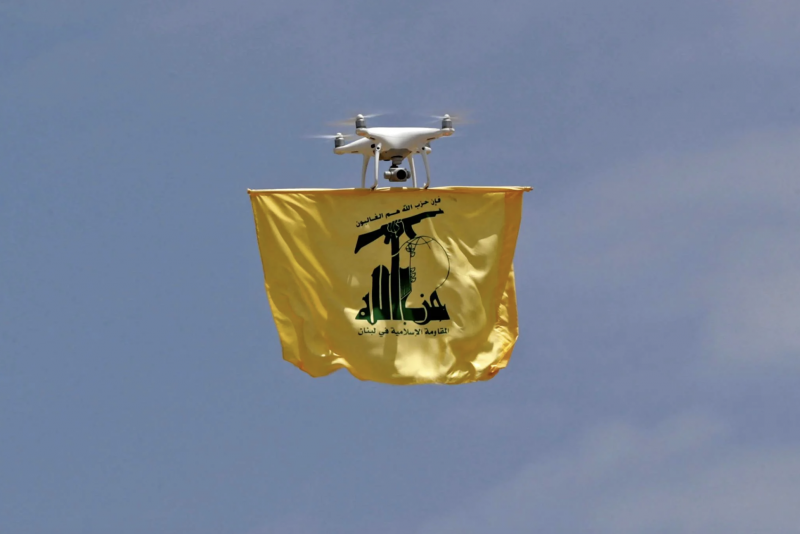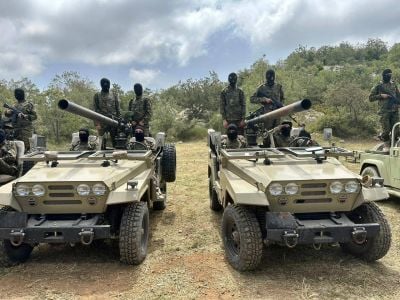
A drone carrying the Hezbollah flag in Aaramta on Sunday during a Hezbollah military parade to celebrate the liberation of southern Lebanon. (Credit: Anwar Amro/AFP)
“Every now and then, Hezbollah likes to put on a show of force,” said Joe Macaron, an independent consultant and research analyst, commenting on Hezbollah’s Sunday military exercise in the town of Aaramta in Jezzine.
The timing of the parade, which was organized to mark the 23rd anniversary of the liberation of South Lebanon from Israeli occupation, carries significant meaning.
Hezbollah’s military show came two days after the 32nd Arab League summit was held in the Saudi city of Jeddah on Friday.
During the pan-Arab meeting, the Saudi Crown Prince Mohammed Bin Salman (MBS) presented his vision of generalized appeasement in the Middle East, amid a rapprochement between Riyadh and Tehran.
Hezbollah finds itself in a new landscape, as the regional powers now consider the war in Syria to be over. This is not to mention the recent agreement on the demarcation of the maritime border between Lebanon and Israel, which reduces the likelihood of a new conflict along the southern border.
In such a context of appeasement, one might wonder about the relevance of Hezbollah’s weapons.
Sunday’s event partially cleared the ambiguity: Despite the prevailing climate of détente, Hezbollah will not give up its arms.
A message to the Lebanese
Hezbollah was keen to show off its weapons on Sunday, including artillery mortars and drones.
The pro-Iranian party’s fighters paraded around on all-terrain vehicles and motorbikes, simulating an attack on an Israeli town. They blew up vehicles and fired live ammunition at targets marked with the Star of David.
“Hezbollah seized the opportunity to send a message to the Israelis and warn them against any attempt to escalate in Lebanon as in Palestine,” said Kassem Kassir, an analyst with close ties to the party.
Hashem Safieddine, the head of Hezbollah's Executive Council, explicitly told reporters that the purpose of Sunday’s show of force was to send a clear message of intimidation to the Israeli government.
“We are telling [Israeli Prime Minister] Benjamin Netanyahu and his incompetent team that we know what they can do, and we know that they will not be able to change the situation,” Safieddine said.
While anti-Israeli rhetoric remains at the heart of Hezbollah’s discourse, the last direct confrontation between the two sides dates back to 2006.
But for many observers, Israel was not the main target of Hezbollah’s message.
“Hezbollah generally considers that military secrecy is its best asset against the Israelis,” Lebanese Forces (LF) spokesperson Charles Jabbour, a fierce opponent of Hezbollah, told L’Orient-Le Jour. “Clearly, on Sunday, the party was sending messages to other local and regional actors.”
Meanwhile, Nicholas Blandford, a researcher at the Atlantic Council and expert on Hezbollah, said, “[Party leader] Hassan Nasrallah was addressing the Lebanese through this military show.”
Hezbollah sought to reinforce its strength in front of its predominantly Shia followers, demonstrating that, even amidst the economic crisis gripping the country, it has not lost any of its glory even 23 years after the liberation of southern Lebanon.
“The party stood idly by during the recent outbreak of violence between [Palestine’s] Islamic Jihad and Israel,” said Ali al-Amin, editor-in-chief of Janoubia News and a vocal Hezbollah critic.
“Hassan Nasrallah has repeatedly stressed his commitment to the unity of the resistance fronts, but has done nothing to defend Gaza and his Palestinian ally, which seriously undermines the legitimacy of his words,” Amin added.“Sunday’s military show of force was an opportunity to reassert itself as a central player in the ‘resistance’ axis.”
Red lines
In the midst of the political tug-of-war between the pro-Hezbollah camp and the opposition, particularly concerning the presidential election, both sides recently heightened their tones.
“If Hezbollah insists on imposing its choice [of president], the country could well be drowned in a new civil war,” said Kataeb leader Samy Gemayel.
Hezbollah and its allies endorsed Marada Movement leader Sleiman Frangieh for the presidency, but the opposition camp has put all its weight behind preventing his election.
The opposition is capable of forcing a lack of parliamentary quorum to prevent Frangieh’s election, especially if supported by Gebran Bassil’s Free Patriotic Movement (FPM). Bassil’s relationship with Hezbollah has recently been strained.
Politically undermined, Hezbollah finds itself in greater need than ever for a display of strength.
“This demonstration serves as a clear indication to its opponents that it remains the most powerful stakeholder, particularly outside the realm of political institutions,” said Amin.
“If Hezbollah thinks that this maneuver can increase the chances of its candidate for the presidency, it is completely wrong,” LF leader Samir Geagea said via Twitter.
“In a regional context that is moving toward appeasement, Hezbollah has signaled to the Arab League and the international community that it is not concerned by what is happening and will continue on the same path of the last 20 years,” Geagea added.
Hezbollah wanted also to convey a message to the regional stakeholders.
Several weeks after the signing of a normalization agreement between Iran and Saudi Arabia in Beijing, Riyadh seems to be adopting more conciliatory positions toward Tehran’s protégés in the region, including in Syria and in Yemen.
The Jeddah summit held on Friday further reinforced Saudi Arabia’s vision for the Middle East, notably exemplified by the return of Syrian President Bashar al-Assad to the Arab League after more than a decade of isolation.
Iran perceives itself as the primary beneficiary of this dynamic, particularly due to the Saudi regime’s willingness to provide the Iranian government with relatively easy gains in these matters.
Given this context, Tehran and its Lebanese counterpart, Hezbollah, show no signs of readiness to soften their stance, particularly concerning the issue of the party’s weapons arsenal.
“Hezbollah believes that concessions should be made by the Saudis, not by itself,” Amin said.
In an effort to appease both local and regional actors, mainly Riyadh, Frangieh promised to initiate a national dialogue regarding Hezbollah’s weapons. This could potentially pave the way for the formulation of a national defense strategy that would require Hezbollah to adhere to its provisions.
Sunday’s exercise, however, served as a strong reminder from Hezbollah: the party’s weapons are not open for debate.
“Our weapons will remain in the hands of our fighters until the victory promised by Hassan Nasrallah is achieved,” said Safieddine at the event.
The next president, whoever he may be, has been warned.
